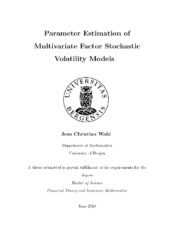Parameter Estimation of Multivariate Factor Stochastic Volatility Models
Master thesis
Permanent lenke
https://hdl.handle.net/1956/18033Utgivelsesdato
2018-06-22Metadata
Vis full innførselSamlinger
Sammendrag
Volatility is a crucial aspect of risk management and important to accurately quantify. A broad range of models and methods tackle this problem, but there is no consensus to exactly which method or model that solves this problem best. We use maximum likelihood and Hamiltonian Monte Carlo to estimate parameters in multivariate factor stochastic volatility models and compare the two alternative methods with the new interweaving strategy proposed in Kastner et al. (2017). Through simulation studies, we show that convergence of the likelihood is unstable and very data dependent. We investigate possible restrictions on our parameters by calculating the characteristic function of our model. We find that restricting the loading matrix (in two dimensions) makes convergence more stable. Furthermore, we introduce the “Nested Laplace Approximation” (where we integrate over the latent variables in a sequential way) and compare to the classical Laplace approximation on two state space models. We also compare the methods on exchange data from 2005-2015. All methods give similar results, but Hamiltonian Monte Carlo is sensitive to the choice of priors.
